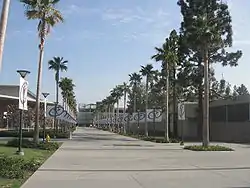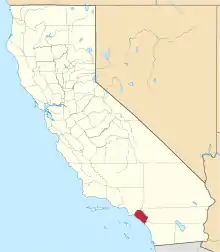Fullerton, California
Fullerton (/ˈfʊlərtən/) is a city located in northern Orange County, California, United States. As of the 2010 census, the city had a total population of 135,161.[6]
Fullerton, California | |
|---|---|
City | |
| City of Fullerton | |
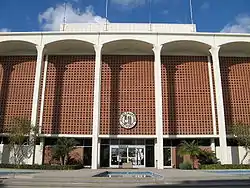 Fullerton City Hall, 2007 | |
 Flag 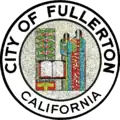 Seal | |
| Motto(s): "The Education Community"[1] | |
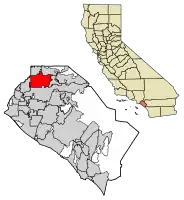 Location of Fullerton in Orange County, California. | |
 Fullerton, California Location in the contiguous United States | |
| Coordinates: 33°52′48″N 117°55′43″W | |
| Country | |
| State | |
| County | |
| Incorporated | February 15, 1904[2] |
| Government | |
| • Type | Council-Manager |
| • City Council[3] | Mayor Jennifer Fitzgerald Mayor Pro Tem Jan Flory Bruce Whitaker Ahmad Zahra Jesus Silva |
| Area | |
| • Total | 22.44 sq mi (58.11 km2) |
| • Land | 22.42 sq mi (58.07 km2) |
| • Water | 0.01 sq mi (0.03 km2) 0.05% |
| Elevation | 164 ft (50 m) |
| Population | |
| • Total | 135,161 |
| • Estimate (2019)[7] | 138,632 |
| • Rank | 7th in Orange County 43rd in California 199th in the United States |
| • Density | 6,182.86/sq mi (2,387.18/km2) |
| Demonym(s) | Fullertonian |
| Time zone | UTC−8 (PST) |
| • Summer (DST) | UTC−7 (PDT) |
| ZIP Codes | 92831–92832 |
| Area codes | 562, 657/714 |
| FIPS code | 06-28000 |
| GNIS feature IDs | 1660658, 2410556 |
| Website | www |
Fullerton was founded in 1887. It secured the land on behalf of the Atchison, Topeka and Santa Fe Railway. Historically it was a center of agriculture, notably groves of Valencia oranges and other citrus crops; petroleum extraction; transportation; and manufacturing. It is home to numerous higher educational institutions, particularly California State University, Fullerton and Fullerton College. From the mid-1940s through the late 1990s, Fullerton was home to a large industrial base made up of aerospace contractors, canneries, paper products manufacturers, and is considered to be the birthplace of the electric guitar, due in a large part to Leo Fender. The headquarters of Vons, which is owned by Albertsons, is located in Fullerton near the Fullerton–Anaheim line.
History
Early history
Evidence of prehistoric animal habitation, such as saber-toothed cats and mammoths, is present in Ralph B. Clark Regional Park in the northwest of the city.[8] Europeans first passed through the area in 1769 when Gaspar de Portolà led a Spanish expedition north to Monterey. From the description recorded in the diary of Father Juan Crespi, it seems likely that the party camped on July 29 near present-day Laguna Lake, in the Sunny Hills area.[9]
After establishment of Mission San Gabriel Arcangel in 1771, the local Tongva people were dubbed "Gabrieliños" by the Spanish. In 1837, the Fullerton area became part of Rancho San Juan Cajón de Santa Ana, granted to Juan Pacifico Ontiveros, a Spanish soldier.
Ontiveros began to sell parcels of the Rancho to migrant Americans settling and developing California in the aftermath of the 1849 Gold Rush, including Massachusetts native Abel Stearns. In the 1860s, Stearns sold in turn to Domingo Bastanchury, a Basque shepherd.
In 1886 while in the area on a duck hunting vacation, Malden brothers George and Edward Amerige, heard rumors that the California Central Railroad, a subsidiary of the Santa Fe Railway, was looking for land. Sensing opportunity, they arranged to buy 430 acres (1.7 km2) north of Anaheim for approximately $68,000.
They then began negotiations with George H. Fullerton, president of the Pacific Land and Improvement Company, also a Santa Fe subsidiary. They offered free right-of-way and half interest in the land to the railroad if Fullerton's survey were revised to include the proposed town site, and on July 5, 1887 Edward Amerige formally staked his claim at what is now the intersection of Harbor Boulevard and Commonwealth Avenue.
In 1894 Charles Chapman, a retired Chicago publisher and a descendant of John "Johnny Appleseed" Chapman, purchased an orange orchard in eastern Fullerton. The Valencia variety of oranges he promoted from his Santa Ysabel Ranch, well suited to the local climate, proved a boon to producers; Fullerton boasted more orange groves than any other municipality in the United States. Cultivation of walnuts and avocados also flourished, and the Western railroad town became an agricultural center. Fullerton was incorporated in 1904, but not officially recognized until 1907, due to conflicts at that time.
Boom years
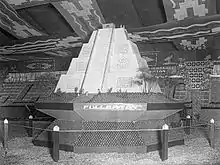
Drilling for petroleum began in 1880 with the discovery of the Brea-Olinda Oil Field and fueled the first real boom, peaking in the 1920s. Construction reflected the vogue for Spanish Colonial and Italian Renaissance-inspired architecture, as in the historic Fox Fullerton Theatre (erected 1925); the home of Walter and Adella Muckenthaler, designed by Frank K. Benchley (erected 1924); and the city's chief landmark, the Plummer Auditorium and clock tower (erected 1930). Fullerton College was established at its present location at Chapman Avenue and Lemon Street in 1913. Meanwhile, the city banned all overnight street parking in 1924— a law enforced to the present day, unless an area is specifically exempted.[10] The period from 1910 to 1950 represented a golden age for the city which like other Southern California cities were marked with elegant architecture ranging from the Beaux Arts Movement to the distinctive California Mediterranean architecture, which in turn were surrounded by bucolic farms and parks. Significant public works projects were constructed during this period, including the conversion of a southwestern sewer farm into Fullerton Municipal Airport at the behest of Placentia ranchers and aviators William and Robert Dowling in 1927. Following the depression, concentration of industry, a depressed farming economy, and cheap land development shattered the earlier period quality of life. Through the mid-1900s the economy shifted toward food processing rather than food production, as well as manufacturing; southeastern Fullerton became an industrial center. Val Vita Food Products (later Hunt Wesson and today part of ConAgra Foods, Inc.) began operating a citrus juice plant in western Fullerton in 1932. By 1941 it had become the largest food processing company in the US. In 1934 A.W. Leo, Tom Yates and Ralph Harrison developed the first Hawaiian Punch recipe in a converted garage in Fullerton. The city also became a producer of aerospace equipment, electrical and electronic components, navigation systems, and laboratory instruments.
In 1949 Dick Riedel and Bill Barris piloted the Sunkist Lady, a modified Aeronca Sedan, out of the Fullerton airport to set an endurance flight record of 1,008 hours and 2 minutes.
Also in 1949, Leo Fender developed and refined the world's first commercially successful solid-body electric guitar, the Fender Telecaster.
Postwar suburbanization
Although Fullerton, like other Southern California cities, had experienced an expansion of population due to housing development, this increased by an order of magnitude during the post war years. Fullerton's population soared after World War II as American veterans migrated to California, bought housing in the land development which destroyed the surrounding farming and park areas, and in particular after the construction of Interstate 5 and development in neighboring Anaheim.
To serve the growing population, the California State Legislature authorized Orange County State College in 1957, which began operating out of Fullerton high schools in 1959. In 1963, it moved to its present campus on State College Boulevard, and later, after several name-changes, was finally redesignated California State University, Fullerton. Other institutions followed, earning Fullerton a reputation as an "Education City." The Fullerton Arboretum, a 26-acre (105,000 m2) botanical garden, opened in the northeastern part of the city adjacent the campus in 1979.
Manufacturing growth leveled off as ever-soaring property prices, increasing environmental regulation, traffic, and other pressures increased. By the late 20th century the city had lost much of its rural character in favor of suburban housing tracts and shopping centers.
Recent history
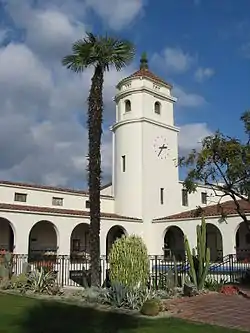
The first years of the 21st century have seen several political issues played out against a backdrop of class division (between the more affluent northern and western parts of the city and the southern portion of the city, which borders Anaheim), rapidly diminishing supplies of undeveloped land, and demographic changes (including the influx of Asian and Latino immigrants into an area previously dominated by Caucasian Americans).
As in many cities, growth and development are contentious issues. In the 1990s, the downtown commercial district had become economically depressed, and was known mainly for being an area of sleepy antique stores and small shops. A symbol of downtown's problems was the Fox Theatre, a local landmark, which had fallen into disrepair. As of November 2004, a fundraising drive had accumulated sufficient funds to buy the theater, but not yet enough money to restore it. By 2006, restoration was started.
During this same period, the downtown area (a.k.a. DTF), especially south of Commonwealth Avenue (a.k.a. SOCO),[11] has become more of a busy entertainment district, described by the OC Weekly as "Bourbon Street West." In less than five years, some 30 businesses that sell alcohol have opened, making the downtown area much more active at night. Ranging from a mixture of Mexican cantinas and Asian bars to Jazz, local venues and music stores, with the festive atmosphere have come problems such as public drunkenness, fights and a shortage of parking. In 2008, City Manager Chris Meyer called together department head and the finance department and reported to the city council that the Restaurant Overlay District (established December 2002)was costing the city $935,000 over and above the sales taxes collected. Then four officers were hired for downtown, bringing the costs to $1,600,000 a year. The ROD had abolished condition use; a new ordinance to establish restrictions was drafted and adopted by the city council in 2008. a police task force last year has addressed some of these problems.
The 293-acre (1.19 km2) Hughes Aircraft Company's Ground Systems Group campus in western Fullerton was redeveloped into a major new residential and commercial district, called Amerige Heights, in 2001–2004. This development was accompanied by extreme shifts in neighborhood property values, first dropping precipitously in the late 1980s to early 1990s as the former Hughes employees sold their houses, and then rising rapidly as part of a general increase in real estate values throughout Orange County.
Geography

Fullerton is located at 33°52′48″N 117°55′43″W (33.879914, -117.928749).[12] It is approximately 25 miles (40 km) southeast of downtown Los Angeles, and approximately 11 miles (18 km) north-northwest of Santa Ana, the county seat. The city has a mean elevation of 150 feet (46 m) and lies approximately 11 miles (18 km) northeast of the Pacific Ocean straight-line distance. It has a Mediterranean climate, with a mean temperature of 62.2 degrees Fahrenheit (16.8 °C).
According to the United States Census Bureau, the city has a total area of 22.4 square miles (58 km2). 22.4 square miles (58 km2) of it is land and 0.01 square miles (0.026 km2) of it (0.05%) is water.
It is bordered by La Habra and Brea on the north, La Mirada on the northwest, Buena Park on the west, Anaheim on the south, and Placentia on the east.
The flat downtown area is laid out in a grid plan centered at the intersection of Harbor Boulevard and Commonwealth Avenue. After recent renewal and beautification projects, it has attracted specialty stores, coffee shops, and restaurants, and has uncharacteristically retained much of its downtown character. Southeastern Fullerton is historically the industrial sector, and is home to small manufacturing, particularly east of Raymond Street and south of Commonwealth.
The northern and western reaches of Fullerton are dominated by the Coyote Hills, a low-lying mountain range divided into the East Coyote Hills and West Coyote Hills. The land south of West Coyote Hills is known as Sunny Hills. For most of the city's history these areas were groves of citrus trees, open scrubland, and oil fields. While equestrian trails and many old estates endure along Bastanchury Road, the meandering roads through these areas today mostly connect a succession of housing tract subdivisions and commercial developments. In recent years, the City Council has tried to allow development in the remaining open land throughout the city. The most notable impending project, in West Coyote Hills, has been met with opposition by many of the citizens in the area.
Climate
According to the Köppen Climate Classification system, Fullerton has a warm-summer Mediterranean climate, abbreviated "Csa" on climate maps.[13]
| Climate data for Fullerton Municipal Airport (1981–2010 normals) | |||||||||||||
|---|---|---|---|---|---|---|---|---|---|---|---|---|---|
| Month | Jan | Feb | Mar | Apr | May | Jun | Jul | Aug | Sep | Oct | Nov | Dec | Year |
| Record high °F (°C) | 95 (35) |
94 (34) |
97 (36) |
106 (41) |
106 (41) |
104 (40) |
113 (45) |
102 (39) |
110 (43) |
107 (42) |
99 (37) |
89 (32) |
108 (42) |
| Average high °F (°C) | 67.8 (19.9) |
68.1 (20.1) |
69.8 (21.0) |
72.8 (22.7) |
75.0 (23.9) |
78.4 (25.8) |
83.2 (28.4) |
85.4 (29.7) |
83.8 (28.8) |
78.5 (25.8) |
72.3 (22.4) |
67.4 (19.7) |
75.2 (24.0) |
| Daily mean °F (°C) | 56.2 (13.4) |
57.9 (14.4) |
59.9 (15.5) |
62.6 (17.0) |
66.3 (19.1) |
69.7 (20.9) |
73.8 (23.2) |
75.3 (24.1) |
73.5 (23.1) |
67.9 (19.9) |
61 (16) |
56.1 (13.4) |
65.0 (18.3) |
| Average low °F (°C) | 44.6 (7.0) |
47.6 (8.7) |
50.1 (10.1) |
52.4 (11.3) |
57.7 (14.3) |
61.1 (16.2) |
64.5 (18.1) |
65.3 (18.5) |
63.2 (17.3) |
57.3 (14.1) |
49.7 (9.8) |
44.8 (7.1) |
54.9 (12.7) |
| Record low °F (°C) | 30 (−1) |
30 (−1) |
37 (3) |
38 (3) |
45 (7) |
50 (10) |
54 (12) |
53 (12) |
51 (11) |
45 (7) |
33 (1) |
32 (0) |
30 (−1) |
| Average precipitation inches (mm) | 3.03 (77) |
3.25 (83) |
2.16 (55) |
0.87 (22) |
0.25 (6.4) |
0.09 (2.3) |
0.04 (1.0) |
0.05 (1.3) |
0.24 (6.1) |
0.75 (19) |
1.10 (28) |
2.05 (52) |
13.88 (353.1) |
| Source: Monthly Climate Normals (1981-2010)- Fullerton Muni AP,CA [14] | |||||||||||||
Economy
According to the city's 2010 Comprehensive Annual Financial Report,[15] the top employers in the city are:
| # | Employer | # of employees |
|---|---|---|
| 1 | California State University, Fullerton | 3,821 |
| 2 | St. Jude Medical Center | 2,928 |
| 3 | Raytheon | 1,446 |
| 4 | Fullerton School District | 1,286 |
| 5 | Fullerton College | 1,094 |
| 6 | Fullerton Joint Union High School District | 1,078 |
| 7 | Alcoa Fastening Systems | 975 |
| 8 | Albertsons | 800 |
| 9 | City of Fullerton | 631 |
| 10 | Kraft Foods | 550 |
Government and politics
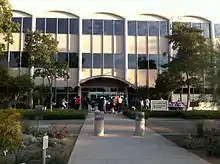
Local Government Organization
Fullerton is a General-law municipality with a council-manager government system. Legislative authority is vested in a city council of five non-partisan members who serve four-year staggered terms, who elect a chair who serves as mayor. Elections are held every two years and are consolidated with the statewide general elections held in November of even numbered years. The city manager is responsible for day-to-day operations.[16][17] Prior to 2016, all council seats were elected at large. In 2016 voters passed Measure II which changed at large representation to election for five districts.[18][19][20]
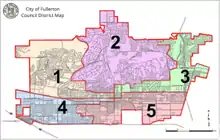
| District | Incumbent |
|---|---|
| District 1 (Northwest) | (Due to be elected in 2020) |
| District 2 (North Central) | (Due to be elected in 2020) |
| District 3 (Northeast) | Jesus Silva, Mayor (2019) |
| District 4 (Southwest) | (Due to be elected in 2020) |
| District 5 (Southeast) | Ahmad Zahra |
| At Large Representative | Jennifer Fitzgerald, Mayor (current),[22] Mayor Pro Tem (2019) |
| At Large Representative | Jan M. Flory, Mayor Pro Tem (current)[22] |
| At Large Representative | Bruce Whitaker |
| Office | Current Occupant |
|---|---|
| City Manager[23] | Ken Domer |
| Chief of Police[24] | Robert Dunn |
| Chief of Fire Department[25] | Adam Loeser |
Allegations of police misconduct
In 2011, a major controversy arose in the city over misconduct by the Fullerton Police, involving sexual assault by an officer against women he arrested[26] and the killing of a mentally ill homeless man by police. This has led to the indictment of two officers and a recall campaign against McKinley, Bankhead, and Jones.[27] Officer Manuel Ramos, 37, was charged with second-degree murder and involuntary manslaughter, and Corporal Jay Patrick Cicinelli, 39, was charged with involuntary manslaughter and felony use of excessive force with regards to the death of Kelly Thomas. They pleaded not guilty.[28] On July 5, 2012, (one year after the beating death), the father of Kelly Thomas filed a lawsuit against the city and six officers, two of whom are facing criminal charges. The lawsuit also names former police chiefs Patrick McKinley and Michael Sellers.[29] The suit alleges the violation of Kelly Thomas' federal and state civil rights; assault and battery; negligence and supervisor liability among others as causes of action. It seeks unspecified damages. Thomas' mother, Cathy, who is divorced from Ron Thomas, has already received a $1-million settlement from the city. On July 3, 2012, Officer Ramos's employment was terminated.[30] Thomas' father eventually received a 5 million dollar settlement from the City of Fullerton. Both Ramos and Cicinelli were found not guilty of any criminal charges. Both were terminated by Fullerton.
Recall Election
In a landslide, city council members Dick Jones, Don Bankhead and Pat McKinley were voted out of office in a June 5, 2012, recall election. Each was voted out by an almost identical majority of nearly 66%. Their replacements are: Travis Kiger, a planning commissioner and blogger for the site Friends for Fullerton's Future, who fills Jones' term, which expires December 4, 2012; Greg Sebourn, a land surveyor, who fills Bankhead's term, which ends December 2, 2014; and attorney Doug Chaffee, who fills McKinley's term, which also ends December 2, 2014. All were sworn into office in July 2012.[31] Tony Bushala, a leading organizer of the Fullerton recall election, said he was seeking accountability for Kelly Thomas' death.[28] The city's other two council members are not facing a recall.
State and federal representation
| Year | Democratic | Republican | Third Parties |
|---|---|---|---|
| 2020[32] | 57.35% 36,693 | 40.20% 25,725 | 2.45% 1,568 |
| 2016[33] | 53.41% 27,410 | 38.97% 20,001 | 7.62% 3,912 |
| 2012[34] | 47.97% 22,960 | 49.15% 23,526 | 2.88% 1,379 |
| 2008[35] | 48.84% 24,106 | 49.27% 24,318 | 1.88% 930 |
| 2004[36] | 40.22% 18,633 | 58.53% 27,114 | 1.24% 576 |
| 2000[37] | 40.00% 16,999 | 55.50% 23,585 | 4.50% 1,911 |
| 1996[38] | 38.31% 15,132 | 51.40% 20,307 | 10.29% 4,065 |
| 1992[39] | 32.12% 14,901 | 45.15% 20,946 | 22.74% 10,550 |
| 1988[40] | 31.13% 13,446 | 67.66% 29,225 | 1.20% 520 |
| 1984[41] | 24.73% 10,734 | 74.21% 32,206 | 1.06% 460 |
| 1980[42] | 22.48% 9,628 | 67.10% 28,735 | 10.42% 4,460 |
| 1976[43] | 35.57% 13,787 | 62.67% 24,289 | 1.76% 680 |
In the California State Legislature, Fullerton is in the 29th Senate District, represented by Democrat Josh Newman, and in the 65th Assembly District, represented by Democrat Sharon Quirk-Silva.[44]
In the United States House of Representatives, Fullerton is in California's 39th congressional district, which has a Cook PVI of EVEN and is represented by Republican Young Kim.[45]
Politics
Historically, Fullerton has been a reliably Republican stronghold in presidential elections; however, former Secretary of State Hillary Rodham Clinton became the first Democrat in over four decades to win the city. According to the California Secretary of State, as of October 22, 2018, Fullerton has 68,867 registered voters. Of those, 25,621 (37.20%) are registered Democrats, 22,233 (32.28%) are registered Republicans, and 18,317 (26.60%) have declined to state a political party/are independents.[46]
Development of West Coyote Hills
West Coyote Hills is a ridge lying mostly in northern Fullerton, including 510 acres (206 ha) owned by Pacific Coast Homes (a land development division of the Chevron Corporation) that are the largest remaining tract of undeveloped land in north Orange County. The current development agreement calls for building houses on some of the land while donating the remainder to the city as a nature preserve. A group that supports keeping the entire area as open space/nature preserve qualified a referendum for a November 2012 election.[47] In the election, voters approved Measure W, which would prevent development in the area.[48] Ongoing lawsuits between the City of Fullerton (pro-development) and local conservationists (anti-development) have resulted over the interpretation of the measure. In February 2019, the California State Supreme Court denied a petition to review a lower court pro-development decision against Measure W. The City of Fullerton and The Friends of Coyote Hills are currently in competing negotiations with Chevron over either purchasing the land for development or donating the land for conservation with Chevron receiving tax credits and conservation funds in exchange for the donation.[49]
Fullerton Transportation Center Redevelopment
In 2019, the city of Fullerton began discussing plans for the redevelopment of the Transportation Center area centered around building a six-story “1930’s industrial-look” hotel.[50]
Education
Public schools
The city of Fullerton is served by three elementary and junior high school districts, two unified school districts, and one high school exclusive school district:
- La Habra City School District
- Buena Park School District
- Fullerton School District
- Brea Olinda Unified School District
- Placentia-Yorba Linda Unified School District
- Fullerton Joint Union High School District
Fullerton has four public high schools within the city limits, all part of the Fullerton Joint Union High School District:
- Sunny Hills High School.
- Fullerton Union High School. The oldest high school in Orange County, it is the home of historic Plummer Auditorium and the Academy of the Arts magnet program.
- Troy High School (which includes Troy Tech, a public magnet program).
- La Vista High School and La Sierra High School (continuation schools, adjacent to Troy)
Other public schooling in Fullerton is provided by the Fullerton School District. There are four public junior high schools, enrolling grades 7-8: Ladera Vista, Nicolas, Parks, and D. Russell Parks Junior High School. Fullerton has only two public elementary K-8 schools: Beechwood and Robert C. Fisler. Fullerton has fifteen public elementary schools enrolling grades K-6: Acacia, Commonwealth, Fern Drive, Golden Hill, Hermosa Drive, Laguna Road, Maple, Orangethorpe, Pacific Drive, Raymond, Richman, Rolling Hills, Sunset Lane, Valencia Park, and Woodcrest.
Roman Catholic schools
Fullerton's Catholic schools are affiliated with the Roman Catholic Diocese of Orange.
- Annunciation Catholic School, formed in 2005 by the merger of Saint Mary's Catholic School, the oldest Catholic school in the city, with Saint Philip Benizi Catholic School, an annex of St. Mary's. Closed in 2011.
- Saint Justin
- Saint Juliana
- Rosary Academy (all-girls')
Other private schools
- Arborland Montessori Children's Academy, 2121 Hughes Drive
- Berkeley School, Academics and the Arts (K-6), 306 N. Pomona Avenue
- IvyCrest Montessori Private School, located where Mayor Hale once lived in the early 1900s
- Eastside Christian School
- West Fullerton Christian School, 2353 W. Valencia Drive, Fullerton, California
Postsecondary institutions
- California State University, Fullerton, commonly known as Cal State Fullerton or CSUF, was first established in 1957 as Orange County State College. The twelfth member of the California State University system, it is currently composed of eight colleges, a community extended education program and several institutions and centers.[51] The main campus is located on 236 acres (0.96 km2) of former orange groves in northeast Fullerton near State Route 57 and Nutwood Avenue. As of 2019, 39,868 students were enrolled in 55 undergraduate and 55 graduate degree programs (including doctorate in education and doctor in nursing practice programs), making it the largest university in the California State University system and the second largest university in the state of California in terms of enrollment. Also known for its music program and typically nationally ranked baseball program.[52][53]
- Fullerton College is a two-year community college, the oldest in continuous operation in California. Part of the North Orange County Community College District, it is situated on a 63-acre (255,000 m2) campus adjacent to Fullerton Union High School on Chapman Avenue and had 25,051 students enrolled as of 2019. The college offers 90 majors leading to A.A. or A.S. degrees in academic and vocational subjects, 68 programs leading to vocational certificates, and transfer programs specializing in preparing students to transfer into the California State University and University of California systems.[54][55][56]
- Hope International University is a private Christian university
- Marshall B. Ketchum University is a health sciences university.
Culture and recreation
Fullerton is home to a vibrant music scene. In the early 1990s, downtown featured several venues that featured bands such as Room to Roam and Trip the Spring. It was a center for the Orange County hardcore punk music scene, producing acts such as The Adolescents, Agent Orange, Social Distortion, D.I., the "fathers of hardcore punk" The Middle Class, Gwen Stefani, lead vocalist of the alternative rock group No Doubt, was a student at CSUF and the group performed there regularly. Other popular groups and musicians from the area include Lit, 80s synthpop acts Berlin and Stacey Q, and Mike Ness. The popular singer-songwriter Jackson Browne attended Sunny Hills High School in the city. Singer-songwriter Tim Buckley also attended Fullerton College and dropped out after only a few weeks to focus on his music career.[57][58] Fullerton is also home to one of the signature cities in the Make Music Day Alliance. Make Music Day is a global annual music celebration occurring on the summer solstice (June 21) each year in more than 1,000 cities in 120 countries across the globe.[59] Starting in 2015, The Day of Music Fullerton[60][61] began as a grass roots initiative by a team of volunteers to create a unique and free music festival in alliance with the internationally renowned Fête de la Musique.[62] Each year on June 21 Fullerton comes alive from morning to night with musicians of all ages and musical persuasions performing in musical venues, shops, bars, restaurants, plazas, churches, parks and parking lots. From high school bands to established musicians/bands, Day of Music Fullerton is open to anyone who wants to perform and enjoyed by everyone who wants to attend for free. Since inception, Day of Music Fullerton has grown into a popular and critical success[63][64][65] hosting over 150 performance in more than 40 venues around the city including the Museum Plaza, Historic Fox Theatre, Hillcrest Park, Villa del Sol, The Muckenthaler Cultural Center among others.[66]
Contributing greatly to Fullerton's musical heritage was the Fender musical instrument company, whose products such as the Stratocaster and Telecaster electric guitars, Precision Bass bass guitar, and Twin Reverb guitar amplifier revolutionized the music business and contributed greatly to the development of rock and roll. Leo Fender sold the company to CBS in 1965; production continued in the Fullerton plant until 1985, when the then-ruined company was sold to a group of private investors. (It was later reconstituted as Fender Musical Instrument Corporation, with its major production facilities in neighboring Corona and across the US-Mexico border in Ensenada, Baja California, and its headquarters in Scottsdale, Arizona.) In 1980, Leo Fender and his original partner George Fullerton (relation to the Fullerton founder of the same name unknown) reunited and started a new company, G&L (George and Leo) Guitars, which are built in what had been Leo Fender's CLF Research factory in Fullerton.[67][68]
The Muckenthaler Cultural Center on Malvern Avenue near Euclid Avenue houses art galleries and a theater group. The former estate of the Muckenthaler family, it was donated to the city by Harold Muckenthaler in 1965. Fullerton Friends of Music, the oldest chamber music society in Orange County, perform five concerts a year at Sunny Hills Performing Arts Center, a notable classical concert venue in the county.[69]
The Fullerton Museum Center is a multidisciplinary exhibit space housed in the old Carnegie Library downtown.
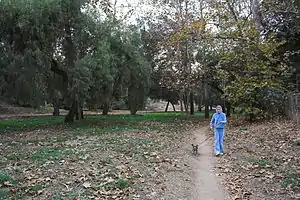
Fullerton is also home to the Fullerton Public Library. The Main Library is located on Commonwealth Avenue in Downtown Fullerton and adjacent to the City Hall. Formerly there was a branch library, called the Hunt Branch on Basque Avenue. The Hunt Branch was closed in 2013[70]
Fullerton is also home to a small but diverse theater scene. Local educational institutions, such as Fullerton College and Fullerton High School's Academy of the Arts, are the source of numerous large-scale productions. California State University Fullerton boasts an award-winning Theatre MFA program.[71] There are also several storefront theaters, including the Maverick Theater, Stages Theater and the Hunger Artists Theatre Company. The Maverick Theatre is the host for the "World Famous Skipper Stand Up Show." Held six times a year, The Skipper Stand Up Show has, since 2006, showcased former and current skippers from Disneyland's famous attraction, the Jungle Cruise.
In addition to the theater scene, Fullerton has garnered attention for rare and international film screenings[72][73][74] hosted by filmmaker Steve Elkins[75][76] at the Hibbleton Gallery in the SOCO district.
Fullerton maintains more than 50 city parks and is home to Hillcrest Park, Chapman Park, and the Orange County Regional parks Craig Regional Park and Ralph B. Clark Regional Park (in neighboring Buena Park, although a small portion lies within Fullerton city limits). The Fullerton Arboretum comprises 26 acres (11 ha) (105,000 m2) of sculpted gardens and unusual plants in northeastern Fullerton. Additionally, the city features approximately 200 acres (0.81 km2) of recreational land in the Brea Dam Recreational Area, plus an equestrian center and trails, two golf courses, a sports complex located southeast of St. Jude Medical Center Hospital and the Janet Evans swim Complex.
The Fullerton city council voted on November 15 to proceed with work on a concept plan for a memorial to Korean War veterans at Hillcrest Park. The project will be funded and developed by The Orange County Korean War Memorial Committee.[77]
For many years, from 1921 to 1984, Fullerton had the largest independent daily newspaper in Orange County, The Fullerton Daily News Tribune. The Fullerton Daily News Tribune circulated 6 days a week, Monday thru Saturday, in all of Fullerton, Brea, Placentia, La Habra, Buena Park, Yorba Linda, and a northern section of Anaheim. At one point in the 1970s The Fullerton News Tribune reached a peak circulation of 30,000 daily subscribers. Formerly owned, for 30 years, by former Scripps newspaper executive Edgar F. Elfstrom, The Fullerton News Tribune was bought by Scripps Howard Newspapers in 1975. In 1984 the Orange County Register bought the Fullerton News Tribune and converted the daily newspaper to a once-weekly free distribution newspaper. Fullerton is also one of the few Southern California municipalities to be served by an independent newspaper, the Fullerton Observer. The Fullerton Observer Community Newspaper is an all-volunteer 40-year old paper that is printed two times a month. It was founded in the late 1970s by Ralph Kennedy, a fair housing and civil rights activist who advocated saving Coyote Hills as an open space. In 2010, the city of Fullerton and the Orange County Register came out in court against the then 32-year-old Fullerton Observer in its request to adjudicate the paper. In response to the city of Fullerton and the Orange County Register's high powered lawyers coming out against the newspaper, the not-for-profit Fullerton Observer dropped its court case to be adjudicated a newspaper.
Fullerton is home to many well known youth sports leagues in baseball, girls fastpitch softball, soccer, basketball, football, swimming and rugby.
Fullerton was also home to the Golden Baseball League's Orange County Flyers (formerly known as the Fullerton Flyers), which disbanded in 2012. The team's home was Goodwin Field, home to the Cal State Fullerton Titans.[78]
The city is also home to Burger Records.[79]
Demographics
| Historical population | |||
|---|---|---|---|
| Census | Pop. | %± | |
| 1910 | 1,725 | — | |
| 1920 | 4,415 | 155.9% | |
| 1930 | 10,860 | 146.0% | |
| 1940 | 10,442 | −3.8% | |
| 1950 | 13,958 | 33.7% | |
| 1960 | 56,180 | 302.5% | |
| 1970 | 85,987 | 53.1% | |
| 1980 | 102,246 | 18.9% | |
| 1990 | 114,144 | 11.6% | |
| 2000 | 126,003 | 10.4% | |
| 2010 | 135,161 | 7.3% | |
| 2019 (est.) | 138,632 | [7] | 2.6% |
| U.S. Decennial Census[80] | |||
2000
In 2000, there were 44,771 housing units at an average density of 2,016.7 per square mile (778.7/km2). There were 43,609 households, out of which 33.0% had children under the age of 18 living with them, 51.8% were married couples living together, 11.0% had a female householder with no husband present, and 32.1% were non-families. 23.5% of all households were made up of individuals, and 7.3% had someone living alone who was 65 years of age or older. The average household size was 2.83 and the average family size was 3.37.
In the city, the population was spread out, with 25.1% under the age of 18, 11.5% from 18 to 24, 32.3% from 25 to 44, 19.8% from 45 to 64, and 11.3% who were 65 years of age or older. The median age was 33 years. For every 100 females, there were 97.7 males. For every 100 females age 18 and over, there were 96.1 males.
The median income for a household in the city was $57,345 (Orange County 2005), and the median income for a family was $75,700. Males had a median income of $40,674 versus $31,677 for females. The per capita income for the city was $23,370. About 8.0% of families and 11.4% of the population were below the poverty line, including 13.6% of those under age 18 and 5.4% of those age 65 or over.[81]
2010
The 2010 United States Census[82] reported that Fullerton had a population of 135,161. The population density was 6,043.9 people per square mile (2,333.6/km2). The racial makeup of Fullerton was 72,845 (53.9%) White, 3,138 (2.3%) African American, 842 (0.6%) Native American, 30,788 (22.8%) Asian, 321 (0.2%) Pacific Islander, 21,439 (15.9%) from other races, and 5,788 (4.3%) from two or more races. Hispanic or Latino of any race were 46,501 persons (34.4%). Non-Hispanic Whites were 38.2% of the population,[83] down from 79.0% in 1980.[84]
The Census reported that 132,084 people (97.7% of the population) lived in households, 2,318 (1.7%) lived in non-institutionalized group quarters, and 759 (0.6%) were institutionalized.
There were 45,391 households, out of which 16,155 (35.6%) had children under the age of 18 living in them, 23,240 (51.2%) were opposite-sex married couples living together, 5,502 (12.1%) had a female householder with no husband present, 2,505 (5.5%) had a male householder with no wife present. There were 2,366 (5.2%) unmarried opposite-sex partnerships, and 290 (0.6%) same-sex married couples or partnerships. 9,771 households (21.5%) were made up of individuals, and 3,342 (7.4%) had someone living alone who was 65 years of age or older. The average household size was 2.91. There were 31,247 families (68.8% of all households); the average family size was 3.43.
The population was spread out, with 31,558 people (23.3%) under the age of 18, 17,522 people (13.0%) aged 18 to 24, 37,764 people (27.9%) aged 25 to 44, 32,465 people (24.0%) aged 45 to 64, and 15,852 people (11.7%) who were 65 years of age or older. The median age was 34.8 years. For every 100 females, there were 96.6 males. For every 100 females age 18 and over, there were 94.4 males.
There were 47,869 housing units at an average density of 2,140.5 per square mile (826.5/km2), of which 24,600 (54.2%) were owner-occupied, and 20,791 (45.8%) were occupied by renters. The homeowner vacancy rate was 1.1%; the rental vacancy rate was 7.0%. 73,127 people (54.1% of the population) lived in owner-occupied housing units and 58,957 people (43.6%) lived in rental housing units.
According to the 2010 United States Census, Fullerton had a median household income of $67,617, with 14.6% of the population living below the federal poverty line.[85]
Infrastructure
Transportation
Fullerton was founded as a railroad town and is still bisected by the BNSF Railway.
The Fullerton Transportation Center is home to train station serving Metrolink and Amtrak and a major north Orange County bus terminal for the Orange County Transportation Authority. The center is located at Harbor Blvd and Santa Fe Avenue. The bus terminal is located north of Santa Fe Avenue and serves routes 26, 43, 143, 543, and 213.[86] The Fullerton Train Station is located south of Santa Fe Avenue.[87]
The Southern California Metrolink commuter rail system serves the city of Fullerton from the Orange County Line (Union Station, Los Angeles to Oceanside, California) and the 91/Perris Valley Line (Union Station, Los Angeles to Perris Valley in Riverside County). Travel time on Metrolink or Amtrak from Fullerton to Los Angeles is approximately 45 minutes.[88] The city is served by two Amtrak lines. The Southwest Chief (running between Chicago and Los Angeles) and the Pacific Surfliner (running between San Diego and San Luis Obispo with major stops at Los Angeles and Santa Barbara).[89]
In addition to the Fullerton Transportation Center, the Orange County Transportation Authority has a park and ride transportation hub in Fullerton located on Orangethorpe Avenue at Magnolia Avenue which makes connections to OCTA routes 25, 26, 30, 33, 35, 529, and 721 (Downtown Los Angeles) and Los Angeles Metro 460 (Downtown Los Angeles).[90][91]
Fullerton is crossed by four state-maintained highways (all maintained by Caltrans' 12th district), three of which are freeways. State Route 91 runs east-to-west down the length of the city south of Orangethorpe Avenue. It intersects with Interstate 5, the Santa Ana Freeway, in the west near Magnolia Avenue and with State Route 57, the Orange Freeway, in the east near State College Boulevard. Imperial Highway, which is part of State Route 90, also runs through a small portion of the north end of the city.
The main road in Fullerton is Harbor Boulevard (served by OCTA route 43/143/543), a 23-mile road running from Costa Mesa to Rowland Heights. Fullerton is composed of many main arterials. Other main south-to-north arterials include Magnolia Street, Brookhurst Street, Lemon Street, Placentia Avenue, Gilbert Street, Raymond Avenue, State College Boulevard (served by OCTA route 57/57X), Brea Boulevard (served by OCTA route 143), Euclid Street (served by OCTA route 37). Rosecrans Avenue, Bastanchury Road (not served by OCTA), Chapman and Malvern Avenues (served by OCTA route 24), Commonwealth Avenue (served by OCTA route 26) and Orangethorpe Avenue (served by OCTA route 30) are the main west-to-east arterials. Yorba Linda Boulevard (served by OCTA route 26) runs along the east end of the city.[92] Minor arterials include Nutwood Avenue, Associated Road, Highland Avenue, Berkeley Avenue, Parks Road/Castlewood Drive, Kimberly Avenue, Acacia Avenue, Valencia Drive, and Dale Street.
Fullerton Municipal Airport, the only general aviation airport remaining in Orange County, located in the southwest of the city, is the last remnant of the Hughes Company in the area, which was prominent in the aerospace industry up until the 1970s. From the early 1970s through the early 1980s the airport was served by Golden West Airlines, one of the larger commuter airlines of the period. The nearest airport with scheduled service is John Wayne Airport (SNA) in Santa Ana.
Emergency services
Fire protection and emergency medical services are provided by the Fullerton Fire Department with ambulance transport by Care Ambulance Service. Fullerton has one full-service hospital with an emergency room, St.Jude Regional Medical Center. The Fullerton Police Department provides law enforcement for the city, while the California State University Police Department provides services around the Cal State Fullerton campus.
Homeless Shelter
From mid-October through mid-March, the Fullerton National Guard Armory at 400 S. Brookhurst Road serves as a winter shelter location for residents of Fullerton, as well as Brea La Habra and Placentia. The facility is able to house 400 each night and is run by Mercy House, a regional homeless assistance organization, under a contract with Orange County.[93][94]
On October 8, 2019, the city took a major step toward opening a homeless shelter. The city council voted 4-0 (with one member absent) to provide the Illumination Foundation $500,000 from the city low-income housing fund to help pay for property improvements at a shelter location the foundation is working on opening in Fullerton. The proposed facility located at 3535 W Commonwealth Ave will be a 150-bed shelter and will include 60 recuperative care beds for homeless residents recently discharged from a hospital or inpatient mental health facility. The facility will only accept referrals from the city and county and will not accept walk ins. The foundation will provide the funds for purchasing the property. Orange County has agreed to fund the operating costs of the facility through the county “Whole Person Care System” program with a small annual contribution from the city of Fullerton.[95][96][97][98]
Fullerton College Stadium
The North Orange County Community College District approved the development of a new football stadium at Fullerton College on November 12, 2019. The new stadium will be built on the site of the existing Sherbeck Field. The proposal is for a 4,400-seat facility. However the approval came with an option to reduce the size of the stadium to 2,000 seats. Anticipated increased traffic congestion around the campus along with concerns about noise and light pollution reducing the quality of life for the surrounding residents raised considerable opposition to the project within the surrounding residential community and the Fullerton City Council had passed a resolution against the new stadium. Fullerton College has been using stadiums at Yorba Linda High School and Fullerton Union High School which is located immediately adjacent to the college campus. In an attempt to appease local concerns, the approval came with restrictions on the use of the stadium by outside groups as well as limitations on the use of the lighting and sound system.[99][100]
Sister cities
See also
- Orange County, California
- Orange County Transportation Authority
- California State University, Fullerton
- Fullerton College
- Hope International University
- Marshall B. Ketchum University
- Fullerton Arboretum
- Fullerton Transportation Center
- Fullerton Public Library
- Muckenthaler House
- Ralph B. Clark Regional Park
- List of sister cities in California
- List of people from Fullerton, California
References
- "City of Fullerton California". City of Fullerton California. Retrieved September 6, 2012.
- "California Cities by Incorporation Date". California Association of Local Agency Formation Commissions. Archived from the original (Word) on November 3, 2014. Retrieved August 25, 2014.
- "Mayor & City Council". City of Fullerton. Retrieved December 5, 2018.
- "2019 U.S. Gazetteer Files". United States Census Bureau. Retrieved July 1, 2020.
- "Fullerton". Geographic Names Information System. United States Geological Survey. Retrieved November 4, 2014.
- "Fullerton (city), California". 2010 census. U.S. Census Bureau. Archived from the original on July 24, 2012. Retrieved May 20, 2014.
- "Population and Housing Unit Estimates". Retrieved May 21, 2020.
- "City of Fullerton Official Website". Ci.fullerton.ca.us. Retrieved November 26, 2011.
- Bolton, Herbert E. (1927). Fray Juan Crespi: Missionary Explorer on the Pacific Coast, 1769-1774. HathiTrust Digital Library. pp. 142–143. Retrieved April 2014. Check date values in:
|access-date=(help) Diary translator Herbert Bolton, in a footnote, describes the camp location as "La Brea Canyon, north of Fullerton" - "Overnight Parking". City of Fullerton. Retrieved December 10, 2018.
- "City of Fullerton - SOCO District". Ci.fullerton.ca.us. Retrieved May 20, 2014.
- "US Gazetteer files: 2010, 2000, and 1990". United States Census Bureau. February 12, 2011. Retrieved April 23, 2011.
- "Fullerton, California Köppen Climate Classification". Weatherbase. Retrieved May 20, 2014.
- FULLERTON, CALIFORNIA – Climate Summary. NOAA NowData Retrieved on March 14, 2014.
- "City of Fullerton CAFR". Retrieved December 28, 2011.
- "Fullerton City Council". City of Fullerton. Retrieved November 14, 2019.
- "Office of the Fullerton City Manager". City of Fullerton. Retrieved November 14, 2019.
- "District Election Mapping". City of Fullerton. Retrieved November 14, 2019.
- "Measure II District Elections". City of Fullerton. Retrieved November 14, 2019.
- "City of Fullerton District Map". City of Fullerton. Retrieved November 14, 2019.
- "2019-2020 Fullerton City Council". Retrieved November 14, 2019.
- Chavez, Wendy; Tran, Diana (December 4, 2019). "Jennifer Fitzgerald appointed as new mayor of Fullerton". The Daily Titan. California State University, Fullerton. Retrieved December 5, 2019.
- "City of Fullerton". City of Fullerton. Retrieved November 14, 2019.
- "Fullerton Police Department". City of Fullerton. Retrieved November 14, 2019.
- "Fullerton Fire Department". City of Fullerton. Retrieved November 14, 2019.
- "Library of Congress Web Archives". webarchive.loc.gov.
- Beltzer, Yvonne (September 22, 2011). "Recall Effort Launched Against Fullerton Council Members | NBC Southern California". Nbclosangeles.com. Retrieved May 20, 2014.
- "3 California councilmen ousted in recall over alleged police brutality - CNN.com". Articles.cnn.com. June 7, 2012. Archived from the original on June 19, 2012. Retrieved May 20, 2014.
- Gregory, John (July 5, 2012). "Kelly Thomas's father files lawsuit on case's 1-year mark | abc7.com". Abclocal.go.com. Retrieved May 20, 2014.
- "Officer charged in Kelly Thomas' death leaves police force | L.A. NOW | Los Angeles Times". Latimesblogs.latimes.com. July 10, 2012. Retrieved May 20, 2014.
- Abby Sewell (June 7, 2012). "Successful Fullerton City Council recall paves way for change - Los Angeles Times". Articles.latimes.com. Retrieved May 20, 2014.
- "Precinct results" (PDF). www.ocvote.com. 2020. Retrieved November 27, 2020.
- "Election data" (PDF). www.ocvote.com. Retrieved August 10, 2020.
- "Election data" (PDF). www.ocvote.com. Retrieved August 10, 2020.
- "Election data" (PDF). www.ocvote.com. Retrieved August 10, 2020.
- "Election data" (PDF). www.ocvote.com. Retrieved August 10, 2020.
- "Election data" (PDF). www.ocvote.com. Retrieved August 10, 2020.
- "Statement of vote : California. Secretary of State : Free Download, Borrow, and Streaming". Internet Archive.
- "Statement of vote : California. Secretary of State : Free Download, Borrow, and Streaming". Internet Archive.
- Statement of the Vote. Sacramento, Calif. : The Secretary. 1968.
- Statement of the Vote. Sacramento, Calif. : The Secretary. 1968.
- Statement of the Vote. Sacramento, Calif. : The Secretary. 1968.
- Statement of the Vote. Sacramento, Calif. : The Secretary. 1968.
- "Statewide Database". UC Regents. Archived from the original on February 1, 2015. Retrieved November 30, 2014.
- "California's 39th Congressional District - Representatives & District Map". Civic Impulse, LLC.
- "CA Secretary of State – Report of Registration – October 22, 2018" (PDF). ca.gov. Retrieved February 16, 2019.
- "Fullerton voters to decide on 760-home project". Ocregister.com. Retrieved May 20, 2014.
- "Fullerton's Open Space Battle Still Ongoing," Voice of OC, March 31, 2016, https://voiceofoc.org/2016/03/fullertons-open-space-battle-still-ongoing/
- "Supreme Court Will Not Hear Measure W Lawsuit" http://www.coyotehills.org/about-west-coyote-hills/current-status/
- Jane, Rands (October 22, 2019). "Transportation Center Hotel Community Meeting". Fullerton Observer. Retrieved October 24, 2019.
- "About CSUF". California State University, Fullerton. California State University, Fullerton. Retrieved December 5, 2019.
- "CSUF Headcount and FTES". California State University, Fullerton. California State University, Fullerton. Retrieved December 5, 2019.
- "California State University, Fullerton Academics". California State University, Fullerton. California State University, Fullerton. Retrieved December 5, 2019.
- "About Fullerton College". Fullerton College. North Orange County Community College District.
- "Fullerton College". Community College Review. Community College Review. Retrieved December 5, 2019.
- "Fullerton College Academics". Fullerton College. North Orange County Community College District. Retrieved December 5, 2019.
- "FC Pictorial History | Fullerton College Library". library.fullcoll.edu.
- Broeske, Pat H. (September 11, 2012). "A Voice Twice Silenced".
- "Make Music Day 2019 Returns on Friday, June 21". NAMM.org. Retrieved November 27, 2019.
- "Day of Music Fullerton - June 21st". Retrieved November 27, 2019.
- "Day of Music Fullerton". www.facebook.com. Retrieved November 27, 2019.
- "Fête de la Musique", Wikipedia, October 11, 2019, retrieved November 27, 2019
- "Best of 2019 – Arts & Entertainment". OC Weekly. Retrieved November 27, 2019.
- Donofrio, Steve (June 19, 2019). "A Guide to Day of Music Fullerton 2019". OC Weekly. Retrieved November 27, 2019.
- "Fullerton's streets will be alive with music Sunday to start off summer". Daily Pilot. June 20, 2015. Retrieved November 27, 2019.
- Donofrio, Steve (June 19, 2019). "A Guide to Day of Music Fullerton 2019". OC Weekly. Retrieved November 27, 2019.
- Fullerton, George (1993). Guitar Legends, The evolution of the Guitar from Fender to G&L. Fullerton: CENTERSTREAM Publishing. pg. 88-98 ISBN 0-931759-69-2.
- "G&L Contact". Glguitars.com. Archived from the original on June 25, 2014. Retrieved May 20, 2014.
- Young, Don (April 1, 2011). Southern California's Anaheim, Long Beach, Catalina Island, Newport Beach, Huntington Beach, San Juan Capistrano & Beyond. Hunter Publishing, Inc. p. 97. ISBN 978-1-55650-211-8.
- Jesse La Tour (February 19, 2019). "Future Uses of the Hunt Branch Library". Fullerton Observer. Fullerton Observer. Retrieved November 14, 2019.
- "Kennedy Center: ACTF - Irene Ryan Acting Scholarship National Winners". February 2, 2014. Archived from the original on February 2, 2014.
- Mason, Amber (April 5, 2016). "The Hibbleton Gallery film series aims to spark meaningful talks".
- "An Introduction to Iranian Cinema".
- "Jesse's Blog: The Cinema of Mali and Tunisia @ Hibbleton Gallery". January 1, 2016.
- "Steve Elkins". IMDb.
- "Filmmaker Steve Elkins Visits ALICE for Next Feature | ALICE Matters". alicematters.web.cern.ch.
- "Korean War Memorial at Hillcrest Park?". Fullerton Observer. Fullerton Observer. November 10, 2019. Retrieved November 18, 2019.
- "Minor League history: Golden Baseball League". Retrieved November 14, 2019.
- "Burger Records". Retrieved November 14, 2019.
- "Census of Population and Housing". Census.gov. Retrieved June 4, 2015.
- "City of Fullerton - 404" (PDF). www.cityoffullerton.com. Archived from the original (PDF) on February 2, 2015.
- "2010 Census Interactive Population Search: CA - Fullerton city". U.S. Census Bureau. Archived from the original on July 15, 2014. Retrieved July 12, 2014.
- "Fullerton (city), California". State & County QuickFacts. U.S. Census Bureau. Archived from the original on July 24, 2012.
- "Race and Hispanic Origin for Selected Cities and Other Places: Earliest Census to 1990". U.S. Census Bureau. Archived from the original on August 12, 2012.
- "Fullerton (city), California". 2010 census. U.S. Census Bureau. Archived from the original on July 24, 2012.
- "OCTA Routes and Schedules". www.octa.net. Orange County Transportation Authority. October 11, 2019. Retrieved November 14, 2019.
- Google (November 14, 2019). "Fullerton Transportation Center" (Map). Google Maps. Google. Retrieved November 14, 2019.
- "Metrolink". Southern California Regional Rail Authority. Retrieved October 15, 2019.
- "California Train Routes". Amtrak. Retrieved October 15, 2019.
- Google (November 14, 2019). "Fullerton Park and Ride" (Map). Google Maps. Google. Retrieved November 14, 2019.
- "OCTA Routes and Schedules". www.octa.net. OCTA. October 14, 2019. Retrieved November 14, 2019.
- "Orange County Transportation Authority". County of Orange, California. Retrieved October 15, 2019.
- Walker, Theresa (October 14, 2019). "Bus pickup to take homeless people to Fullerton Armory night shelter has four north Orange County locations". Orange County Register. Retrieved October 24, 2019.
- Chavez, Wendy; Tran, Diana (November 7, 2019). "Fullerton City Council passes vote to create a center to address homelessness". The Daily Titan. California State University, Fullerton. Retrieved December 5, 2019.
- Custodio, Spencer (October 10, 2019). "Fullerton Takes First Step to Open a Homeless Shelter". Voice of OC. Retrieved October 20, 2019.
- LaTour, Jesse (October 20, 2019). "Council Approves Funding for Homeless Facility". Fullerton Observer. Retrieved October 20, 2019.
- "Fullerton City Council Meeting – October 8, 2019". City of Fullerton. Retrieved October 20, 2019.
- Rands, Jane (November 4, 2019). "Council to Vote on Proposed Homeless Facility". Fullerton Observer. Retrieved November 5, 2019.
- Park, Jeong (November 16, 2019). "Fullerton College will convert its Sherbeck Field into a stadium with lights". Orange County Register. Retrieved November 18, 2019.
- La Tour, Jesse (November 14, 2019). "Trustees Approve Fullerton College Stadium, but May Reduce Size". Fullerton Observer. Fullerton Observer. Retrieved November 18, 2019.
External links
| Wikimedia Commons has media related to Fullerton, California. |
 Fullerton travel guide from Wikivoyage
Fullerton travel guide from Wikivoyage- Official website

- Downtown Fullerton
- Fullerton Chamber of Commerce
- Fullerton Heritage
- Fullerton News (the Orange County Register)
- The Daily Titan (Fullerton Newspaper - California State University)
- The Hornet (Fullerton Newspaper - Fullerton College)
- Fullerton Observer
- California State University, Fullerton
- Fullerton College
- Fullerton Transportation Center
- Fullerton Community Center
- Fullerton Library
